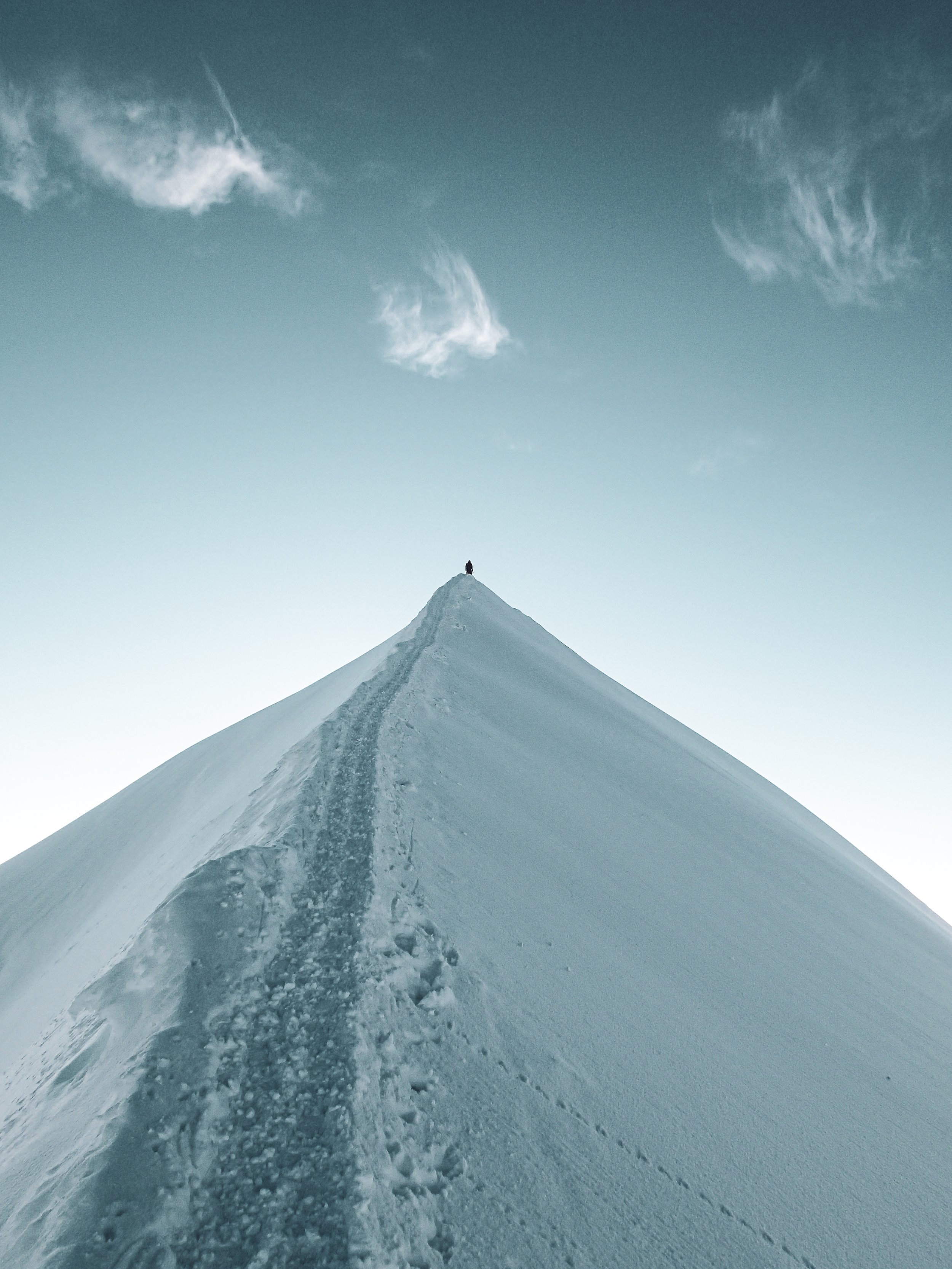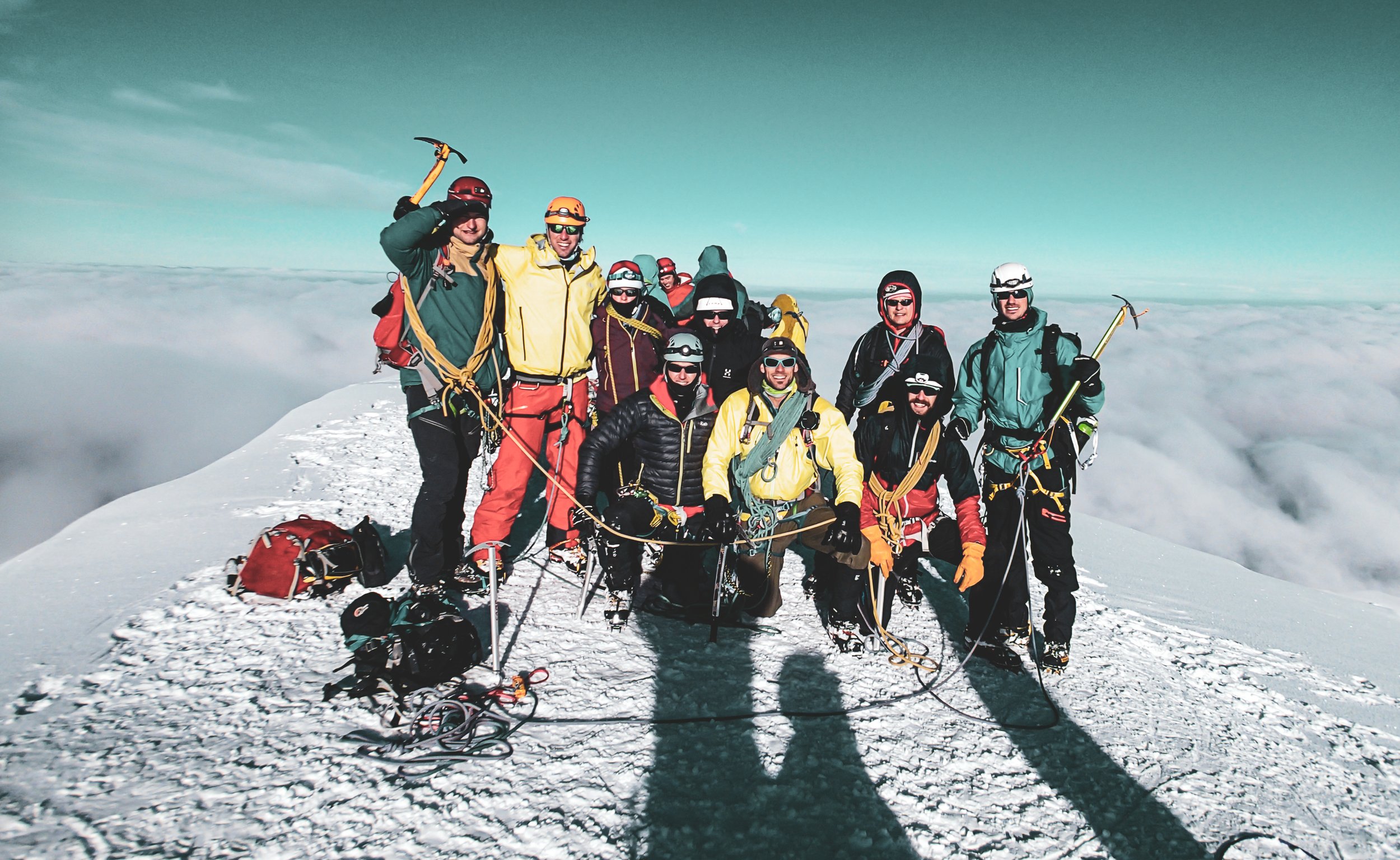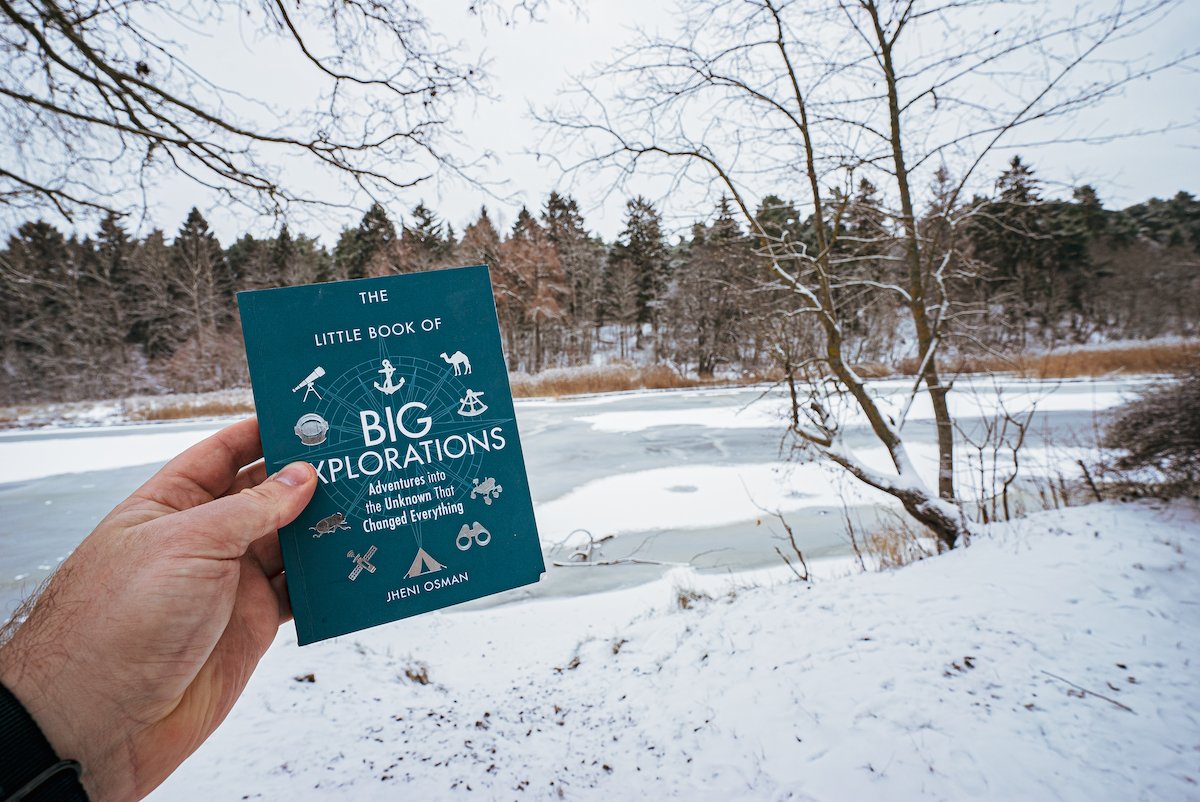
Standing on the roof of Europe:
What it’s like to summit Mont Blanc
About the author: Chris Shirley MA FRGS
A former Captain in the Royal Marines, Chris has been an advisor on the BBC’s High Risk and News Safety team, has led the risk management function in an international media charity, and has been an international disaster responder with Re:Act for a number of years.
He holds a master’s degree in business management, has travelled in over 60 countries, is a fellow of the Royal Geographical Society (FRGS), is a Guinness World Record holder, has rowed across the Atlantic in a 5-person team, completed the Marathon des Sables, Ironman triathlons, and many ultra-distance events.
For those who fight for it, life has a flavour the sheltered will never know’
~ Theodore Roosevelt 26th US president (and Mont Blanc summiteer).
Roosevelt was right; life does have a habit of appearing in full colour when you embrace danger. And what a fight! This huge lump of rock and ice did not relent easily.
As the highest mountain in Western Europe, Mont Blanc (‘White Mountain’) stands at an impressive 4,810 metres (15,762 feet) – that’s around half the height of Mount Everest, or 11 times the height of New York’s Empire State building, to give it context.
Despite being 4,000m shorter than our planet’s apex peak, I freely admit that I approached it as barely more than a walk in the park: around 20,000 climbers successfully summit every year (although in the bar afterwards, we did meet a pair of Slovenian climbers for whom the peak had evaded them for three years running).
The team meets for the first time
On an unseasonably warm afternoon in early September 2016, our team of 12 adventurers met for the first time in Geneva airport, and set about excitedly chatting about the trip. My good university friend, Toby, had organised this trip many months ago and put it out to a mixed ability group of Brits, Germans, Canadians and an Italian.
Everyone had different backgrounds and levels of experience; for my part, despite being a former Royal Marine, I had limited high-altitude or extreme cold weather experience. I’d always wanted to deploy on the annual cold weather warfare exercise in Norway, but always found myself in busy with other things. Others in the group had a lot of experience; some had even climbed Morocco’s 4000+ metre Toubkal Mountain earlier that year.
You might also be interested in:
Training
Pre-training for the climb was difficult. I’d come to France almost directly after having spent a month in Kabul, Afghanistan. Due to the security situation there, I couldn’t go running or even for a walk up the many beautiful rocky hills that surround the city like giant sleeping guardians. The best way I could train with the resources at my disposal was to do short, sharp plyometric workouts in the sparsely ventilated basement gym. Whilst this sounds pretty grim, it actually had its benefits: Kabul sits at approximately 1,800 metres above mean sea level (about 800m higher than Chamonix), so between the elevation and undertaking hi-intensity, interval training (HIIT) in an un-air conditioned, carbon dioxide-rich environment, my respiratory system had to work harder to maintain the same level of output.
Effects of altitude
It is widely recognised that the effects of altitude reduce your maximal aerobic power (VO2 max) by around 2% for every 300 metres you climb over 1,500 m elevation. This means you lose around 22-25% of the maximum volume of oxygen your body can use at the summit of Mont Blanc.
To become conditioned to this, we spent many hours working at increasingly higher elevations. Our first exposure started relatively low down; a 3-hour hike and scramble up the beautiful Via Corda Alpina, a relatively easy trail (PD+ / 3C) that ends at a mountain café overlooking the spectacular Aveyron gorge.
What great fun! We only packed a few essential safety items (bivvy bag, of course – goes everywhere, emergency food, phone charger, GPS and a Silva compass to name but a few), and then set off. The scramble was fun, quick and challenging, and we raced our way to the café for a celebratory beer whilst the sun set over the incredible vista.
The next few days were spent at ever increasing altitude to practice our winter skills: things like working with crampons; how to self-arrest if you fall; how to move as a rope team; how to cross a crevasse; and basic alpine knot revision.
Our first night sleeping at altitude was spent at the Cosmiques refuge near the Aiguille du Midi cable car. The overnight stop was planned to give us prolonged exposure to higher altitude (3,613 metres or 1,200 less than the summit), and it’s a good thing we took it: the increase in altitude really affected a couple members of the team. Knowing how well conditioned to altitude you are is a key safety consideration in mountaineering – it would be dangerous for the individual and group to continue pushing higher if the capability to perform is not yet there.
For evening entertainment, one of the guys delved into his backpack and pulled out a pristine set of Uno cards, and after a brief revision of the rules (and a fresh round of beers), we set about playing until late into the night.

As the highest mountain in Western Europe, Mont Blanc stands at an impressive 4,810 metres – that’s around half the height of Mount Everest, or 11 times the height of New York’s Empire State building!
Crossing the infamous Grand Couloir
The biggest physical risk on the approach to summit Mont Blanc was the Grand Couloir. Also known as ‘death gully,’ this rock funnel holds boulders frozen into its roof, periodically releasing them without warning. To get to the Goûter hut, climbers have no choice but to cross it via a precarious one metre-wide path. Rock fall is often inconsistent and could strike at anytime, and can cause serious injury or death (According to French mountain police records, between 1990 – 2011 - 74 deaths and 180 injuries requiring air evacuation occurred in the Grand Couloir).
We found the best way to cross this obstacle was to post lookouts on either side of the gully. These lookouts observed up the mountain and gave the all clear to release a team of 3 to run across.
I and two other guys formed the lookout group. We were the first to run across, and then moved up high into a position from which we could look up the mountain for the first signs of rock fall while remaining sheltered behind some big rocks, should it occur. After a quick check that our bags were secured and boots properly tied, we legged it across the exposed part of the gully as fast we could. Within seconds of getting behind our cover, I noticed two very odd-shaped silhouettes near the sun on the horizon.
Within what felt like minutes, my mind made sense of what my eyes had just seen, realised they were not in fact birds, and I screamed the words:
“ROCKFALL..ROCKFALL..ROCKFALL..!”
We were under fire.
The three of us in the advance group hunched as tightly as we could into the rock, as a boulder the size of a large suitcase came hurtling down the mountain and missed us by a few feet, passing through the exact spot where I had stood only seconds earlier. It felt like a scene from the film Final Destination, how close we’d just come.
Once the rock-fall had finally stopped, we gingerly moved out from the safety of cover. Still shaking from our narrow miss, we moved up the ridge, always keeping watch for another rock-fall and other places of shelter. The air was tense.
After what felt like 10 minutes of slowly creeping up the ridgeline, we took our places. My heart was still racing from the unexpected adrenaline dump I’d just experienced, and I struggled to focus. Remembering a mindfulness technique that I had learnt a few months earlier, I counted my breath to allow my limbic system to regain control of my highly aroused amygdala. Thankfully, It worked enough for me to concentrate on supporting the remainder of our team to get across and into the welcoming safety of the ridgeline. When everyone had crossed, we grouped to reflect on what had happened. Nervous laughter cloaked the realisation that we had been dangerously close to catastrophe.
Gear
“Travel light, freeze at night”
Our approach to the climb was to travel light to give us the best possible chance of summiting. To do this, we booked places in the Goûter hut, which stands around 3,815 metres high. This meant we wouldn’t be taking the heavier items such as sleeping bags or cookers but would still take vital kit such as bivvy bags, down jackets, avalanche probes etc.
From the hut, we woke around 1am and stepped off at 2am, with a plan of summiting around dawn, then heading back down to catch the last cable car to Chamonix.
Eating was an interesting experience. Part of me wanted to take traditional boil-in-the-bag mountain meals, but instead I decided to try a more traditional diet of whatever was available in Chamonix. I took Toby’s sage advice and packed a base of cheese and salami.
This served well on 3 counts:
a) It didn’t freeze;
b) It gave me enough fat to sustain long aerobic exercise (whereby fat is the main source of energy); and
c) It lasted throughout the day and tasted good despite the temperature.
Around the base of cheese and salami, I added more easily accessible items to eat on the hoof, such as nuts, chocolate bars (also important for morale), crisps and flapjacks. I packed a sufficient quantity and variety of food to give me enough energy if for any reason we couldn’t eat at the Goûter hut. Since the hut is mostly supplied by helicopter, I figured there was a reasonable risk this could occur.
The Goûter Hut
After the close encounter crossing the Grand Couloir, the team made its way up the remainder of the Via Ferrata route in relative quiet. Almost everyone spent some time dwelling on thoughts of what might have happened if we’d been a few moments slower or quicker. Our collective spirit had been dealt a hand in reality; we knew we had been extremely lucky not to take a casualty on the crossing. After around 7 hours, we got to the Goûter hut and set into our familiar routine of checking in, identifying our beds and working through our kit quickly enough to get to sleep. Around dinner, the team reflected on that afternoon’s experience and quickly made light of it. We’d spent five days together as a team, and had bonded to the point that, terrifying as it was, the Grand Couloir experience only made us stronger. After a couple of very expensive yet hugely anticipated beers, we made our way to our dorms to get some much needed rest – we would be waking in 6 hours to start our climb in complete darkness.
The longest day
After many nervous trips to the bathroom, I woke up at 1:15 am to start the short list of tasks to be ready to set off at 2 am. My body was tired after the previous day’s scrambling, but the prospect of finally seeing the summit in mere hours was more than enough motivation. ‘Rope team awesome’ (as we’d named our trio) was to lead the two other groups to the summit. Now it got really exciting.
After bidding au revoir to two of our group suffering from extreme vertigo and altitude sickness, the remaining three teams set off up the mountain in search of the summit. The scene at night was spectacular: the Milky Way and constellations were all in full view and would easily distract you from looking out for crevasses and not stepping on the rope with your sharp crampons.
As the hours passed, we slowly snaked our way up the mountain. We first found our way onto the Dome du Goûter, a huge flat plateau that looked enormous in the dark night. From there, we continued to trail blaze through the fresh powdery snow and onwards to our next rendez-vous (RV)– the Vallot Hut.
By now, we’d reached 4,300 metres – still 500 m (vertical height) from the summit. We stopped briefly when we realised that one of our 10 remaining group members was getting quite sick. The thin air and cold had hit him hard. According to my Garmin watch, it was hovering around -20C, and we still had a long way to go up an incredibly narrow ridge, the infamous Bosses Ridge.
We’d heard a story of a climber who had died only a week earlier on the Bosses Ridge when his crampon caught on his other trouser leg, sending him sliding to his death. This chilling reminder of the real dangers one faces on the mountain made it an easy decision to safely deposit our suffering team member in the warmth and safety of Vallot Hut. Here he could get warm and acclimatise to the lower oxygen level whilst we pushed on to the summit, collecting him on the way back down.
With many false peaks, Mont Blanc constantly tricks you into thinking you are near the top. I lost count of the number of times I went through the two-step cycle of elation of summit, followed by frustration that it was in fact, not the summit and there was still a long way to go. Maybe someone should rename it the mountain of false summits (Montagne des Faux Sommets?).
As the day wore on, I could feel my energy dropping and body succumbing to the altitude. Above 4,600 metres, I was only able to manage up to 10 small steps before having to rest on my ice axe and suck in oxygen. My lungs were beyond simply asking me to stop – they were now telling me.
But as the sun started to break free of the horizon, so too did my spirit. The air became warmer and the climb became slightly easier – this was the effect of being in daylight.
The real summit
As we trudged up the ridgeline and onto the long flat summit, I felt not a sense of elation, but of relief. The uphill yomp was over and we’d reached our goal. By now, the sun was high above the horizon and illuminating the surrounding mountains in an ethereal, heavenly light, as if congratulating us for pushing on and reaching the top. The air felt warm and a calm silence had descended over everyone. I allowed myself time to enjoy the scene, before getting my camera out to capture the scenes of elation. My tired brain struggled to compose proper photos, so I shot on autopilot in the hope that I would somehow capture the beauty, effort and tranquillity of the moment. After the congratulations and photos had finished, we knew what was coming, but no one wanted to say it:
‘What goes up….’






